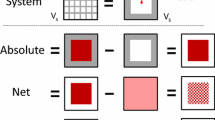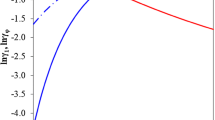Abstract
The oxygen fugacity (\(f_{O_2 } \)) of a C-O-H fluid in equilibrium with graphite has been determined in the range 10–30 kbar by equilibrating solid \(f_{O_2 } \)-buffer assemblages in graphite capsules containing C-O-H fluid. By using different buffers (FexO-Fe3O4, Ni-NiO, Co-CoO, Mo-MoO2), the \(f_{O_2 } \) of the graphite-saturated fluid is bracketed within a narrow range. This technique produces a calibration for the \(f_{O_2 } \) imposed on a sample contained within a graphite capsule. To achieve a thermodynamically-invariant system at fixed P and T, the \(f_{H_2 } \) was imposed on the system with an external buffer and the double-capsule technique. The experiments were performed in solid-media, high pressure apparatus with 19 mm tale-pyrex assemblies. A series of experiments at 10, 15, 20, 25, and 30 kbar, 800–1600° C, with \(f_{H_2 } \) imposed by the Fe2O3-Fe3O4-H2O equilibrium were conducted. The experimental results have been fitted to the following equation:
(T in K, P in kbar). This equation reproduces the experimental results to ±0.1 log \(f_{O_2 } \). The results show that the experimentally-determined \(f_{O_2 } \) of the graphite-COH fluid equilibrium is close to the equilibrium calculated by combining thermodynamic data with a modified Redlich-Kwong (MRK) or virial-type equation of state for the derivation of the fugacity coefficients. At P≥20 kbar, the virial-type equation (Saxena and Fei 1987, 1988) reproduces the experimental results better than does the MRK, which produces a difference of 0.8 log \(f_{O_2 } \) at 800° C and 30 kbar.
Similar content being viewed by others
References
Bottinga Y, Richet P (1981) High pressure and temperature equation of state and calculation of the thermodynamic properties of gaseous carbon dioxide. Am J Sci 281:615–660
Boyd FR, England JL (1960) Apparatus for phase equilibrium measurements at pressures up to 50 kilobars and temperatures to 1750° C. J Geophys Res 65:741–748
Chase MW Jr, Davies CA, Downey JR Jr, Frurip DJ, McDonald RA, Syverud AN (1986) JANAF thermochemical tables, 3rd edn, Pts I and II. American Chemical Society and American Institute of Physics, New York
Darken LS, Gurry RW (1945) The system iron-oxygen. I. The wüstite field and related equilibria. J Am Chem Soc 67:1398–1412
Eugster HP (1957) Heterogeneous reactions involving oxidation and reduction at high pressures and temperatures. J Chem Phys 26:1760–1761
Flowers GC (1979) Correction of Holloway's (1977) adaption of the modified Redlich-Kwong equation of state for calculation of the fugacities of molecular species in supercritical fluids of geologic interest. Contrib Mineral Petrol 69:315–318
Haselton HT, Sharp WE, Newton RC (1978) CO2 fugacities at high temperatures and pressures from experimental decarbonation reactions. Geophys Res Lett 5:753–756
Holloway JR (1977) Fugacity and activity of molecular species in supercritical fluids. In: Fraser DG (ed) Thermodynamics in Geology, Reidel, Dordrecht, The Netherlands, pp 161–181
Holloway JR (1981) Compositions and volumes of supercritical fluids in the Earth's crust. In: Hollister LS, Crawford ML (eds) MAC Short Course in fluid inclusions: Applications to petrology. Mineralogical Association of Canada Short Course vol 6, Calgary, Canada, pp 13–35
Holmes RD, O'Neill HSt, Arculus RJ (1986) Standard Gibbs free energy of formation for Cu2O, NiO, CoO, and FexO: High resolution electrochemical measurements using zirconia solid electrolytes from 900–1400 K. Geochim Cosmochim Acta 50:2439–2452
Kerrick DM, Jacobs GK (1981) A modified Redlich-Kwong equation for H2O, CO2, and H2O-CO2 mixtures at elevated pressures and temperatures. Am J Sci 281:735–767
Kushiro I (1976) Changes in viscosity and structure of melt of NaAlSi3O8 composition at high pressures. J Geophys Res 81:6347–6350
Lindsley DH (1966) Pressure-temperature relations in the system FeO-SiO2. Carnegie Institution of Washington Year Book 65:226–230
Luth RW (1989) Natural versus experimental control of oxidation state: Effects on the composition and speciation of C-O-H fluids. Am Min 74:50–57
O'Neill HSt (1986) Mo-MoO2 oxygen buffer and the free energy of formation of MoO2. Am Min 71:1007–1010
O'Neill HST (1988) Systems Fe-O and Cu-O: Thermodynamic data for the equilibria Fe-“FeO”, Fe-Fe3O4, “FeO”-Fe3O4, Fe3O4-Fe2O3, Cu-Cu2O, Cu2O-CuO from emf measurements. Am Min 73:470–486
Robie RA, Hemingway BS, Fisher JR (1978) Thermodynamic properties of minerals and related substances at 298.15 K and 1 bar (105 Pa) pressure and at higher temperatures. U.S. Geological Survey Bull 1452; pp 1–456
Saxena SK, Fei Y (1987) High pressure and high temperature fluid fugacities. Geochim Cosmochim Acta 51:783–791
Saxena SK, Fei Y (1988) The pressure-volume-temperature equation of hydrogen. Geochim Cosmochim Acta 52:1195–1196
Shmonov VM, Shmulovich KI (1974) Molal volumes and equation of state of CO2 art temperatures from 100 to 1000° C and pressures from 2000 to 10000 bars. Akad Nauk SSSR — Doklady Earth Sci Sect 217:206–209
Thompson RN, Kushiro I (1972) The oxygen fugacity within graphite capsules in piston-cylinder apparatus at high pressures. Carnegie Inst Wash Year Book 71:615–616
Weidner JR (1982) Iron-oxide magmas in the system Fe-C-O. Canadian Mineralogist 20:555–566
Weast RC (1981) CRC Handbook of Chemistry and Physics, 61 edn. CRC Press, Bosa Raton, Florida
Woermann E, Knecht B, Rosenhauer M, Ulmer GC (1977) The stability of graphite in the system C-O, extended abstract. The Second International Kimberlite Conference, Bishop's Lodge, Santa Fe, New Mexico
Woermann E, Stier B, Rosenhauer M (1982) The oxygen membrane cell — a device for controlling the oxygen fugacity in water-free high pressure systems. In: Schreyer W (ed) High pressure researches in geoscience. Schweizerbart'sche Verlagsbuchhandlung, Stuttgart, pp 519–528
Author information
Authors and Affiliations
Rights and permissions
About this article
Cite this article
Ulmer, P., Luth, R.W. The graphite-COH fluid equilibrium in P, T, \(f_{O_2 } \) space. Contr Mineral Petrol 106, 265–272 (1991). https://doi.org/10.1007/BF00324556
Received:
Accepted:
Issue Date:
DOI: https://doi.org/10.1007/BF00324556




